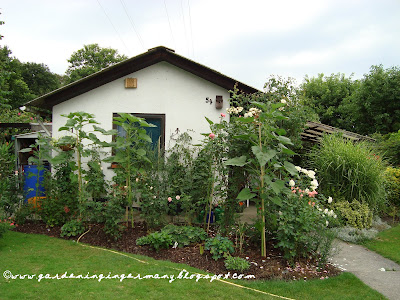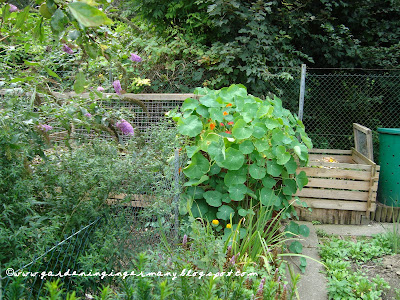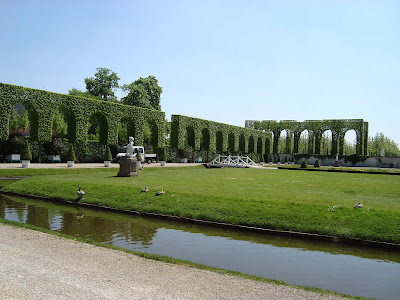Are any of you other gardeners out there having a late summer battle against jungle-like vegetables and flowers? I'm afraid I misjudged just how huge some things can get. Here are some examples.
Zucchinis
Next year the zucchinis will not be in the potager proper. They do not conform to the rule of thumb that no plant should be taller than the horizontal dimensions of the bed it's in. Also, I'm only going to have one plant instead of two. I have moss roses (aka purslane) I grew from seed (portulaca grandiflora) that only blossom when the sun shines on them, and the zucchinis have effectively prevented this. So every day I chop off huge leaves - up to two feet in diameter - to give them and also my boxwoods some light. The zucchinis are supposedly a climbing variety. That may well be, but they have conquered every pole I tried to fasten them to, just too heavy. One day an entire plant had collapsed on the ground, and I needed my husband to lift it. (Please click to enlarge.)
Here views of the moss roses right after I chopped off some zucchini leaves and a little later after they'd then gotten some sun. What you see on the stevia is a snail collar. If you have a slug problem like I do, I highly recommend them. My stevia was almost completely devoured and is now doing nicely.
Sunflowers
A gardening friend gave me some small seedlings after I'd admired her sunflowers last year. I planted them in one of my rose beds, carefully protecting each of the small plants with a snail collar. They turned into hardy plants, and when they'd reached about 2 meters in height (about 6.5 feet) I expected them to start blooming, as hers long since were. Here a shot of how they looked at this height.
But no, some of them didn't even have marked buds at this height, and they just kept growing and growing, jack-and-the-beanstalk-like. They've now reached over 3 meters (over 12 feet) and are starting to bloom, with up to 20 blossoms per stalk! I'm afraid some of the roses and my potted tomatoes along the wall of the cottage might not be getting enough sun, but think they are spectacularly worth it.
The flowers are already attracting birds and bumble bees.
Nasturtium (Kapuzinerkresse)
My predecessor in the allotment had attempted to build a brick compost container, which turned out to be impractical since it had no earth contact and was impossible to empty. He soon realized this and had just closed it with a board. I decided to fill it with earth and see if it would work as a raised bed. As a first try I planted nasturtium (Tropaeolum majus) in it with great results. No aphids either. They haven't blossomed a lot, but the leaves are beautiful and a perfect cover for a previous sore spot in the garden. I am having to cut it back, though, in order to get to the compost bins.
Blackberries
OK, I admit that our sprawling blackberries are running riot because of pruning mistakes, although I do sort of enjoy the jungle-like feeling they give our patio enclosure. Our neighbor has kindly offered to help us prune them this year. HIS blackberries are perfect, and he's already pruned them for the winter, leaving just one or two stalks per plant. I'm sure we'll have a better harvest if we're more severe about pruning. I have to frequently chop away at them to ensure the survival of the Kerria japonica (Ranunkelstrauch) we planted in the spring.
Monday, August 30, 2010
Wednesday, August 25, 2010
Hiking through the Swabian Highlands
From August 18 - 22 I hiked with two girlfriends through the Swabian Highlands from Metzingen to Blaubeuren. The Swabian Highlands are an area in Southwest Germany between Stuttgart and Ulm, known for harsh climate, moors, sparse population, castles and beautiful scenery. We arranged to have our luggage transferred from hotel to hotel, making the hiking - about 15 miles a day - much easier.
We began by hiking straight up from Metzingen to the top of the bluffs marking the border of the Highlands.
From the top there were spectacular views of the town of Metzingen below us, and the Hohen Neuffen castle ruins in the distance (at least I think that's which castle it was). Please click to enlarge.

Once up on the high plateau, we walked through some of the moorland characterized by juniper bushes and, for example, carline thistles, which I'd previously only seen in the Alps.
Our first day's destination was the pretty town of Bad Urach with its picturesque market square. Our hotel was also in the typical half-timbered style.
Near Bad Urach we passed the Urach waterfall.
The next day we headed for Feldstetten, our next destination, passing many lovely meadows on the way. Please do click to enlarge.
In the Swabian Highlands, towns are fewer and farther apart than in most of Germany. Every time we did come to a town, it seemed every house had its own kitchen garden full of flowers and vegetables. Marigolds, dahlias, hibiscus and hollyhocks were abundant.
Balconies were also often full of flowers, mostly petunias and geraniums.
On our way from Feldstetten to Blaubeuren on the third day, we first passed through typical agricultural scenery. The wheat variety known as spelt is grown here, as are, traditionally, lentils. The cornfields and beautiful skies were sometimes reminiscent of my college days in Iowa!
The second half of the day led through a large protected forest reserve which is being left alone as a biotope. Here we encountered some of the wild orchids the Highlands are known for.
This area really seemed like an enchanted forest. We found a small shelter for taking a rest and wouldn't have been surprised to encounter Hansel and Gretel.
After spending the night in the beautiful town of Blaubeuren, we decided to spend our last day hiking around its environs rather than hiking on to Ulm as originally planned. Blaubeuren is famous for the karstic spring which is the source of the Blau River. The spring is in a pool of water in the forest that looks incredibly blue, known as the "Blautopf" (= pot of blue). Here are some views from the hiking trail around and above it.
Here another view of the bucolic River Blau outside of town on its way to flow into the Danube in Ulm.
Blaubeuren is also home to a large monastery, unfortunately without the cloister gardens I was hoping for. Perhaps because it housed only monks and no nuns?
After our last day's beautiful hike we headed for the railroad station for the trip home. On the way I noticed that the city had planted wildflowers in many public spaces such as along sidewalks and embankments. They were a lovely farewell following a great hiking vacation.
If anyone's interested, I can recommend some of our hotels along the way. We also had excellent food everywhere we went, including trout from the area.
We began by hiking straight up from Metzingen to the top of the bluffs marking the border of the Highlands.
From the top there were spectacular views of the town of Metzingen below us, and the Hohen Neuffen castle ruins in the distance (at least I think that's which castle it was). Please click to enlarge.

Once up on the high plateau, we walked through some of the moorland characterized by juniper bushes and, for example, carline thistles, which I'd previously only seen in the Alps.
Our first day's destination was the pretty town of Bad Urach with its picturesque market square. Our hotel was also in the typical half-timbered style.
Near Bad Urach we passed the Urach waterfall.
The next day we headed for Feldstetten, our next destination, passing many lovely meadows on the way. Please do click to enlarge.
In the Swabian Highlands, towns are fewer and farther apart than in most of Germany. Every time we did come to a town, it seemed every house had its own kitchen garden full of flowers and vegetables. Marigolds, dahlias, hibiscus and hollyhocks were abundant.
Balconies were also often full of flowers, mostly petunias and geraniums.
On our way from Feldstetten to Blaubeuren on the third day, we first passed through typical agricultural scenery. The wheat variety known as spelt is grown here, as are, traditionally, lentils. The cornfields and beautiful skies were sometimes reminiscent of my college days in Iowa!
The second half of the day led through a large protected forest reserve which is being left alone as a biotope. Here we encountered some of the wild orchids the Highlands are known for.
This area really seemed like an enchanted forest. We found a small shelter for taking a rest and wouldn't have been surprised to encounter Hansel and Gretel.
After spending the night in the beautiful town of Blaubeuren, we decided to spend our last day hiking around its environs rather than hiking on to Ulm as originally planned. Blaubeuren is famous for the karstic spring which is the source of the Blau River. The spring is in a pool of water in the forest that looks incredibly blue, known as the "Blautopf" (= pot of blue). Here are some views from the hiking trail around and above it.
Here another view of the bucolic River Blau outside of town on its way to flow into the Danube in Ulm.
Blaubeuren is also home to a large monastery, unfortunately without the cloister gardens I was hoping for. Perhaps because it housed only monks and no nuns?
After our last day's beautiful hike we headed for the railroad station for the trip home. On the way I noticed that the city had planted wildflowers in many public spaces such as along sidewalks and embankments. They were a lovely farewell following a great hiking vacation.
If anyone's interested, I can recommend some of our hotels along the way. We also had excellent food everywhere we went, including trout from the area.
Monday, August 9, 2010
A visit to the Schwetzingen palace gardens
In early summer I visited the Schwetzingen palace gardens with an old friend. It's one of those places that's so close by that I don't seem to get around to going there much. But I should! What a fabulous place. There are many great websites (also here, and here is a very good brochure in English) on these gardens if you're interested. In this post I'll concentrate on the incredible tree-lined avenues in the park.
Although the gardens include many highlights such as a large formal French-style garden, English-style landscaping, a mosque, temples to various Greek gods, lakes, fountains, an orangery, and of course the palace, it was the trees that struck me most this time. Almost anywhere you look there are axes of perfectly symmetrically trimmed trees offering astonishing perspectives on the many sights (click to enlarge any photo).
Here's another view of the same ensemble.
When the palace and garden were originally built in the 18th century, at the same time a tree-lined boulevard was built from Schwetzingen castle to Heidelberg. It was lined with mulberry trees in the hopes of encouraging the silk industry! Not much is left of the six-mile avenue or the mulberry trees, but within the palace grounds there are still plenty of avenues. This one reminds me of an aqueduct.
 | |||||||||||||
In the photos below, the formally-pruned "hedge" of trees forms the border between the baroque French garden and the more English-style landscaped garden beyond it.
Some more impressions:
And just so you don't get the impression there are no flowers in these gardens:
And to close, here's a shot of one of the parrots that have invaded many of the area's parks, also in Mannheim. They survive the winters here and apparently are originally from South Asia. I believe the correct name is Alexandrine Ringneck Parakeet. Some people have come to regard them as an invasive pest, as they drive native birds away from feeding places. But it's always astonishing to encounter one. (Better click to enlarge this one.)
I highly recommend a visit if you're ever in southern Germany. Schwetzingen is very close to both Mannheim and Heidelberg.
Subscribe to:
Comments (Atom)









































